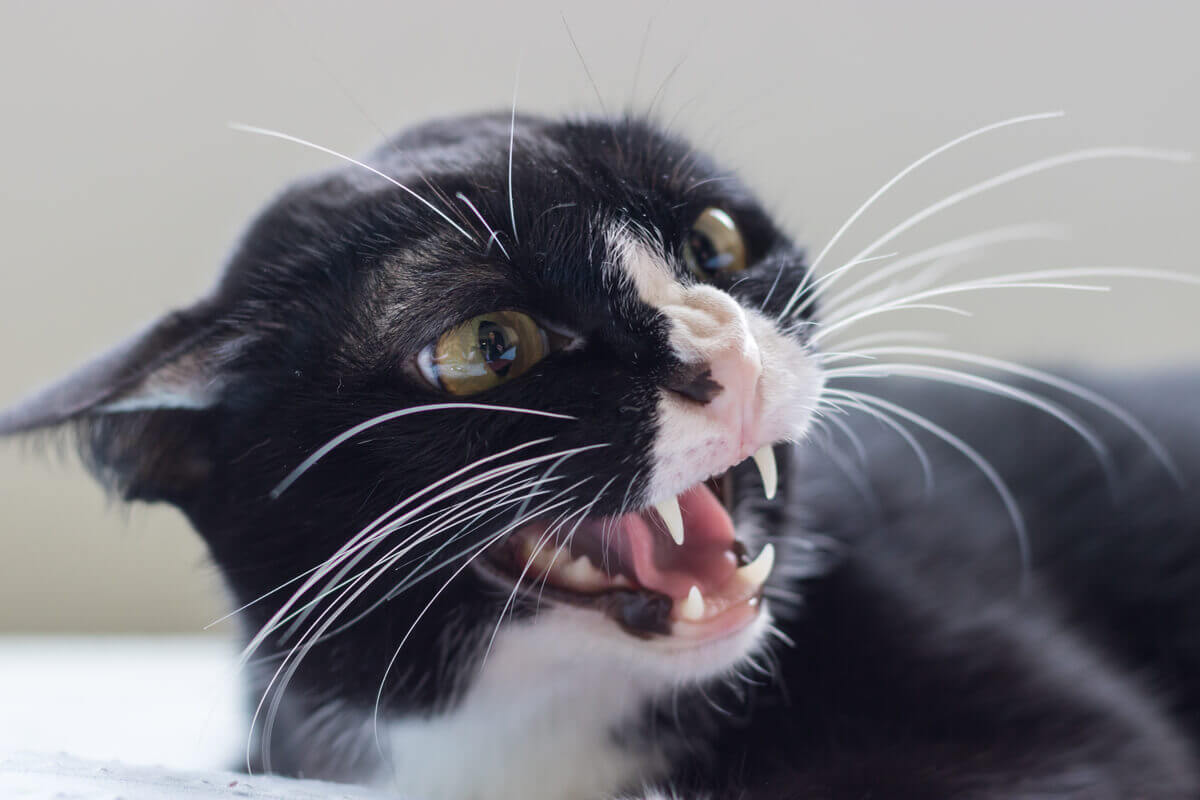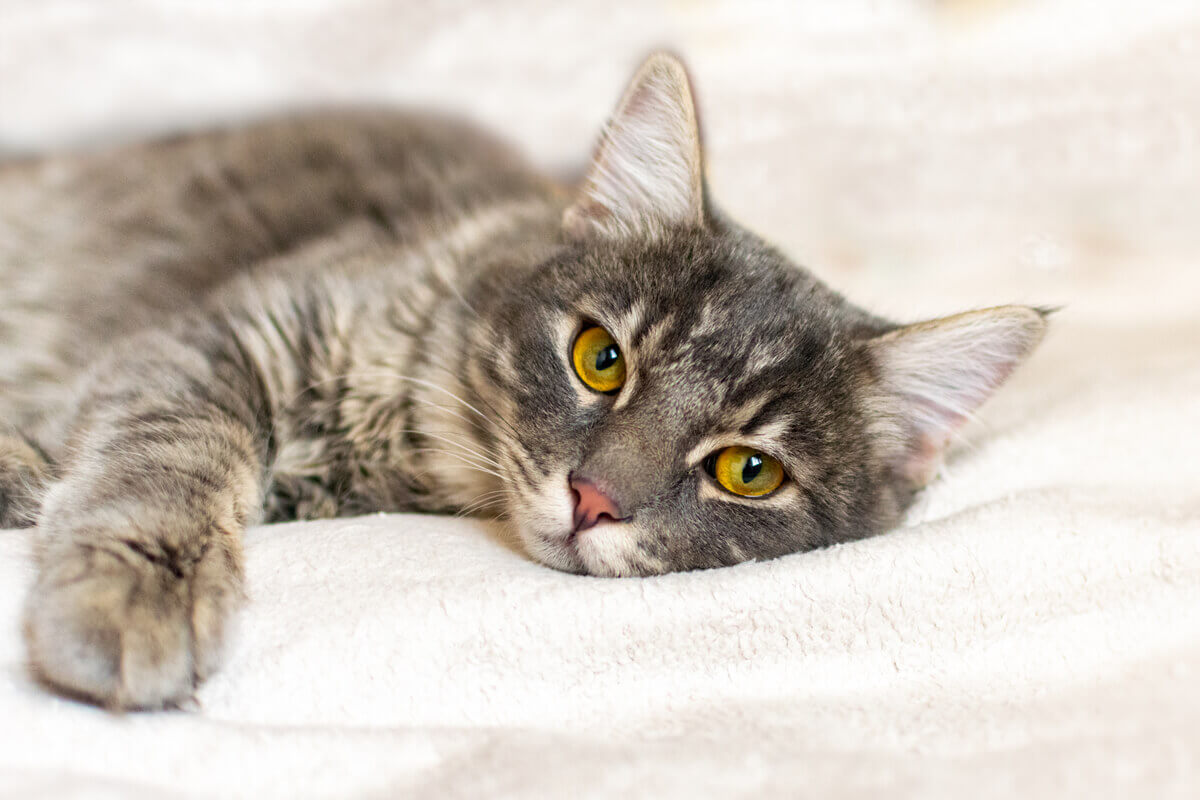The 4 Most Common Behavioral Disorders in Cats

Sharing space and routine with another animal species is a profound and enormously enriching experience for humans. Even so, achieving a good coexistence is crucial when it comes to preventing behavioral disorders in cats.
So, do you want to learn more about the nature of cats and what behavioral disorders can develop out of their characteristics? You’ll find some very useful information below
That’s just how cats are
Ignore the title of this section. Cats, like all species, have their individual and unique nature. Although some species share certain trends, it’s important to know cats intimately in order to properly judge when an owner may be dealing with behavioral disorders in cats.

- They’re solitary animals: They tend to forage and move around individually. In addition, cats mark and fight for their territory. In the wild, they usually only seek one another out in order to mate.
- They’re independent: People often mistake them for being cold and distant animals, but nothing could be further from the truth. It’s just that there are moments when cats aren’t interested in interacting with their owner. At the same time, they don’t require too much attention when it comes to meeting their needs.
- Cats very curious: Generally, any new object will cause interest in felines and they’ll always look for new horizons when their world becomes small. As you’ll read later, this is something you should consider to prevent stress and certain accidents.
- They’ve been with us for many years: Dealing with cats is something that goes back to many civilizations. Therefore, both species have some instinctive basis for understanding one another. Pay attention to what you see.
Cats and stress
The coexistence of a cat with a human in an environment prepared for the latter can lead to a certain degree of stress for the feline. It’s important to identify which of these stimuli may be stressing the feline, as cats are generally prone to stress when any of the components of their environment change.
Some behavioral disorders in cats
Here are the most common behavioral disorders in cats. There are many more, but these are the ones that cause the most visits to the vet.
1. Abnormal stools
There are many complaints when cats defecate or urinate outside of their litter box. All cat owners will have had an accident of this kind. But, if you analyze it carefully, you’ll always find an underlying reason.
If you observe behavior in cats such as defecating or urinating outside the litter box or in specific places, this may be due to several factors:
- Some element in their environment is causing them stress. Perhaps they don’t like the litter in the litter box, or it’s in a place that causes them anxiety. Cats may be suffering from stress due to noise sources, strong smells, or some other element that you may not realize is a problem.
- Territoriality. More common in uncastrated males than in other individuals, cats may urinate outside their box to mark their territory. This usually occurs when the cat feels its space has been invaded. This can be either by a human or the introduction of a new animal into the home. Certain smells may also be affecting this instinct.
- Health problems. Cats may be exhibiting this pattern because of a health problem – pain or kidney problems, for example. The amount of urine, its color or the shape and/or consistency of the feces are signs to look out for when considering an organic disorder.
2. Aggressiveness
Aggression or agonistic behavior in domestic cats can have many causes. In addition, it’s necessary to be prepared as owners, as it usually manifests itself through attacking behavior, such as scratching or snorting.
Isolated aggressive behavior shouldn’t be confused with behavioral disorders in cats. Like any other animal, cats react negatively to agonistic stimuli, such as invasion of territory or personal space. To avoid these, it’s best to get to know the animal so that its needs can be respected.
3. Abnormal intake
Excessive, too fast, or even no dietary intake may be a sign of one of a behavioral disorders in cats. It’s important to consider the environmental conditions in which the cat eats, such as temperature or the presence of other animals.
The amount of food at feeding time may also be important. For example, if the cat has been hungry at some point in its life, it may have developed food anxiety. On the other hand, if it’s suffering from stress due to an external factor or illness, it may stop eating.
4. Scratching behavior
A distinction must be made between typical nail-sharpening behavior and scratch marking. The latter is carried out as an informative, rather than aggressive, method to indicate the individual’s own presence in its territory.
When nail marking is done compulsively, this can be an indication of behavioral disorders in cats. You can assume that your cat feels the need to mark those objects that it considers as its own – and that it doesn’t want anyone to touch – because it’s stressed about its personal space.

The importance of asking for help with behavioral disorders in cats
Getting to know the feline in your house is essential in order to know what’s normal and what may be an indication of the presence of behavioral disorders in cats. However, if attempts to remedy these behaviors are unsuccessful, it’s time to visit the vet.
Sharing space and routine with another animal species is a profound and enormously enriching experience for humans. Even so, achieving a good coexistence is crucial when it comes to preventing behavioral disorders in cats.
So, do you want to learn more about the nature of cats and what behavioral disorders can develop out of their characteristics? You’ll find some very useful information below
That’s just how cats are
Ignore the title of this section. Cats, like all species, have their individual and unique nature. Although some species share certain trends, it’s important to know cats intimately in order to properly judge when an owner may be dealing with behavioral disorders in cats.

- They’re solitary animals: They tend to forage and move around individually. In addition, cats mark and fight for their territory. In the wild, they usually only seek one another out in order to mate.
- They’re independent: People often mistake them for being cold and distant animals, but nothing could be further from the truth. It’s just that there are moments when cats aren’t interested in interacting with their owner. At the same time, they don’t require too much attention when it comes to meeting their needs.
- Cats very curious: Generally, any new object will cause interest in felines and they’ll always look for new horizons when their world becomes small. As you’ll read later, this is something you should consider to prevent stress and certain accidents.
- They’ve been with us for many years: Dealing with cats is something that goes back to many civilizations. Therefore, both species have some instinctive basis for understanding one another. Pay attention to what you see.
Cats and stress
The coexistence of a cat with a human in an environment prepared for the latter can lead to a certain degree of stress for the feline. It’s important to identify which of these stimuli may be stressing the feline, as cats are generally prone to stress when any of the components of their environment change.
Some behavioral disorders in cats
Here are the most common behavioral disorders in cats. There are many more, but these are the ones that cause the most visits to the vet.
1. Abnormal stools
There are many complaints when cats defecate or urinate outside of their litter box. All cat owners will have had an accident of this kind. But, if you analyze it carefully, you’ll always find an underlying reason.
If you observe behavior in cats such as defecating or urinating outside the litter box or in specific places, this may be due to several factors:
- Some element in their environment is causing them stress. Perhaps they don’t like the litter in the litter box, or it’s in a place that causes them anxiety. Cats may be suffering from stress due to noise sources, strong smells, or some other element that you may not realize is a problem.
- Territoriality. More common in uncastrated males than in other individuals, cats may urinate outside their box to mark their territory. This usually occurs when the cat feels its space has been invaded. This can be either by a human or the introduction of a new animal into the home. Certain smells may also be affecting this instinct.
- Health problems. Cats may be exhibiting this pattern because of a health problem – pain or kidney problems, for example. The amount of urine, its color or the shape and/or consistency of the feces are signs to look out for when considering an organic disorder.
2. Aggressiveness
Aggression or agonistic behavior in domestic cats can have many causes. In addition, it’s necessary to be prepared as owners, as it usually manifests itself through attacking behavior, such as scratching or snorting.
Isolated aggressive behavior shouldn’t be confused with behavioral disorders in cats. Like any other animal, cats react negatively to agonistic stimuli, such as invasion of territory or personal space. To avoid these, it’s best to get to know the animal so that its needs can be respected.
3. Abnormal intake
Excessive, too fast, or even no dietary intake may be a sign of one of a behavioral disorders in cats. It’s important to consider the environmental conditions in which the cat eats, such as temperature or the presence of other animals.
The amount of food at feeding time may also be important. For example, if the cat has been hungry at some point in its life, it may have developed food anxiety. On the other hand, if it’s suffering from stress due to an external factor or illness, it may stop eating.
4. Scratching behavior
A distinction must be made between typical nail-sharpening behavior and scratch marking. The latter is carried out as an informative, rather than aggressive, method to indicate the individual’s own presence in its territory.
When nail marking is done compulsively, this can be an indication of behavioral disorders in cats. You can assume that your cat feels the need to mark those objects that it considers as its own – and that it doesn’t want anyone to touch – because it’s stressed about its personal space.

The importance of asking for help with behavioral disorders in cats
Getting to know the feline in your house is essential in order to know what’s normal and what may be an indication of the presence of behavioral disorders in cats. However, if attempts to remedy these behaviors are unsuccessful, it’s time to visit the vet.
All cited sources were thoroughly reviewed by our team to ensure their quality, reliability, currency, and validity. The bibliography of this article was considered reliable and of academic or scientific accuracy.
Chávez Contreras, G. (2016). Etología clínica veterinaria del gato: guía práctica de abordaje para médicos veterinarios. Ediciones Universidad Santo Tomás.
Bueno, Á. R. (2020). Etología felina: Guía básica sobre el comportamiento del gato (1.a ed.). Amazing Books.
Velásquez Pulgarin, A. F., Bernal Velasco, M. A., & Suarez Cárdenas, M. A. (2016, julio). Conductas estereotípicas y compulsivas en perros y gatos; diagnostico y tratamiento. Revista CENderos, 6. http://mail.cen.edu.co/investigacion/volumen6.pdf#page=10
This text is provided for informational purposes only and does not replace consultation with a professional. If in doubt, consult your specialist.








